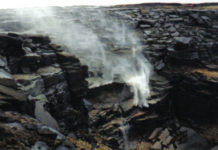Ancient continents like Atlantis have created a huge fascination among the believers and enthusiasts of its existence and there could be plenty such places yet to be discovered. One such continent called Mu or Lemuria may not only have existed but also could be linked to the trail of the origin of Lemurs.
Ancient legends tell of a great continent now lost under the sea. Sanskrit tradition calls the continent ‘Rutas’ and says that it sank under the Indian Ocean. Tamil writings recorded on palm tree bark tell of a giant land mass that connected southern India to Australia. All across the islands of the Pacific Ocean, there are legends of a massive continent that was the birthplace of Man and which sank under the waves. This lost land we now refer to as ‘Mu’ or ‘Lemuria’.

James Churchward, an Anglo-American traveller, wrote the first accounts of Mu legend. He said he was taught Mankind’s original tongue, a dialect called ‘Naacal’, by an Indian priest. This holy man then showed him some old stone tablets hidden in a temple, written in this ancient language. These tablets explained that Mu was a continent in the Pacific Ocean. Placed just below the equator, it was 5,000 miles long and 3,000 miles wide.
If these animals had all descended from a common ancestor ..then there must have once been a land link between these areas.
The tablets said that Mankind had appeared on Mu two million years ago, and a highly advanced society of 64 million people had developed on the island before they were all but wiped out by a huge volcanic eruption. Around the same time as Churchward was publicising his legend and tradition-based theory, another more scientific group were advancing the idea of a lost land. Naturalists and zoologists who followed and believed Charles Darwin’s theory of evolution were finding it particularly difficult to explain the widespread existence of lemurs.
If these animals had all descended from a common ancestor, as Darwin suggested, then there must have once been a land link between these areas. One of Darwin’s followers, an English zoologist called Philip L. Schlater, proposed the name ‘Lemuria’ for this invented sunken land bridge. As science has progressed since Darwin’s time, zoologists can now account for the wide distribution of the lemur family without resorting to creating ideas of ancient missing land masses.
Many critics do not consider Lemuria a valid scientific hypothesis. But at the same time, genetic discoveries have proven that, because of a massive natural catastrophe that almost induced human extinction, all of Mankind originally stems from a small pool of biological variations.
Although there is a discrepancy on the account of Lemuria’s existence even among the believers, all share a common thought that such a continent existed in ancient history. One of the major reasons of its disappearance could have been a catastrophic event like pole shift.
-end-





































Wondering if Greenland’s very thin layer of continental rock is because it left most of its basement rock on the sea floor when it was drawn North in a spiral magnetic field?
And if one was to examine Antarctica for the same lack, would it also be found to be thinly bottomed with continental rock?
It appears that the actions of our magnetar sun, Sol, act on one hemisphere at a time. At least it did when the magnetar had sufficient energy to do so. Now only a dipole rules after an extremely brief monopole which heats our Earth’s core, after which the heated core rapidly disseminates heat upward, igniting volcanic eruptions. In the past, the heat was great enough to heat the ocean bottoms and extinct life. Organized, synchronized and compact life is created by the monopole sun; life of the dipole is disorganized, loosely structured and expansive because it has insufficient energy to hold itself firmly together.